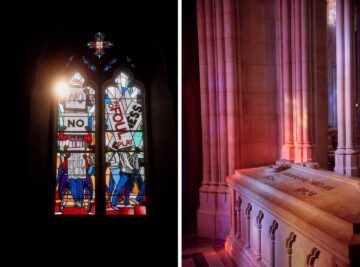Sarah Lewis in The Washington Post:
In the summer of 2022, I went to the cathedral and found myself just feet from President Woodrow Wilson’s tomb and memorial. Along with others, I had been invited to speak about the new commission that the church had just unveiled: stained-glass windows and tablets by artist Kerry James Marshall and poet Elizabeth Alexander to replace those dedicated to Confederate generals Thomas “Stonewall” Jackson and Robert E. Lee. The Confederates’ stained-glass windows had remained in the church for nearly 70 years, erected through a gift from the United Daughters of the Confederacy (UDC). The tomb of Wilson, the first Southerner elected president after the Civil War, had been deliberately installed beneath these stained glass windows.
More here.

 On March 31, 1968, days before he would be assassinated, the Rev. Martin Luther King Jr.
On March 31, 1968, days before he would be assassinated, the Rev. Martin Luther King Jr.